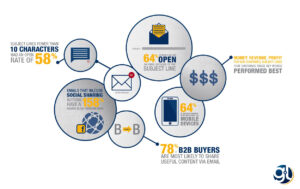 Email subject lines are the gatekeepers to a successful email campaign. The amount of click throughs or conversions may hinge on just a few words. So, it’s time to ask yourself, are you maximizing that subject line.
Email subject lines are the gatekeepers to a successful email campaign. The amount of click throughs or conversions may hinge on just a few words. So, it’s time to ask yourself, are you maximizing that subject line.
Think about how many emails you receive in a day, on average. I counted more than forty in just 24 hours, and that is onle from one of my five email accounts. This number, which varies from person-to-person, is what effects a marketers opportunity to reach prospects by email. Because of this, crafting an actionable and “operable” email subject line is the key to capturing your audience’s attention.
Here are a few tips to ensure subject lines receive equal attention and influence:
1) Ask A Question: Statements may be easily overlooked. If you ask a question, specifically one that your audience consistently faces, that incites interest. Have the answer to a pain point? Prove it. And it goes without saying, make sure that the internal content pays off the subject line!
2) Be Specific: Ambiguity may possess intrigue, but getting right down to what you have to offer is key. Your audience is compelled by content they know applies to them. A study by Mailchimp expressed a key attribute to success: “When it comes to email marketing, the best subject lines tell what’s inside, and the worst subject lines sell what’s inside.”
3) Character Length: Keep in mind that these days email is often checked on the go. In fact, 64% of decision-makers read their emails from mobile devices. In turn, many suggest keeping a subject line to no more than 40 characters. While there’s no hard and fast rule to subject length, get to the point. And don’t forget about the email preview seen on most smartphones. That first line or two must be compelling.
4) Reference Location: If you can tailor a subject line to a geo-targeted demographic, do so. When the content being offered can have a direct impact on the audience, readability increases. This detail will resonate with your audience a lot more than a generalized subject line.
5) Segmentation: Don’t assume all of your recipients share the same goals. Instead, segment your audience and tailor the subject line to what will apply to them most. It’s crucial they know the content will be to their benefit. Prospects, clients and customers have different intentions in mind, so make sure their needs are met.
6) Test: Want to determine what works best for your audience? Test those subject lines. Create A/B tests for your next email blast. Try one of each of these tips to see what works with your targets. The next outreach you make, apply two different subject lines, and discover which leads to more sales.
There are no exact rules to follow for email campaigns, but these tips mixed with your knowledge of the target audience sets you up for success. And just remember, your goals can only be achieved by experimentation.
(Infographic Statistics Source)